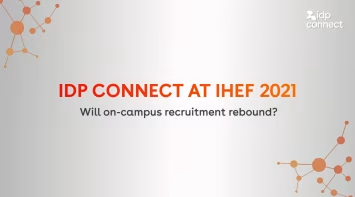UK institutions have seen a significant increase in applications over recent years and this has, in many cases, meant slower than desirable response and turnaround times. The government’s aim to have 600,000 international students enrolled in UK institutions by 2030 was achieved in the 2020/21 academic year and while it is undoubtedly a fantastic achievement, the speed with which volume has increased has caused issues.
We wanted to find out how admissions teams across the country are handling the current challenges and how we can help institutions find solutions that will improve efficiency and student experience.
As IDP’s FastLane technology headed towards its one-year-in-operation milestone, we went on the road to speak to admissions professionals from a range of institutions around the country. We held three workshops, in Edinburgh, Manchester and London, with admissions leaders from institutions across the country. We wanted to understand the issues they are facing and, more importantly perhaps, we were keen to hear about how they are addressing the problems. Ultimately, we want to be able to share best practices and the lessons learned, as well as provide an understanding of how IDP can play a more significant role in making the admissions experience better for students and institutions alike. This is what we discovered.
The challenges admissions teams are currently facing
Volume and staff shortages
Since the ending of UK lockdown, and a return to near-normal travel and course delivery models, the sheer volume of applications has led to difficulty for admissions teams across the UK. One institution told us applications for January 2023were up by around 450% (as of November 2022).
Unexpected and increasing volume are, on their own, major hurdles for admissions teams, but when they combine with staff shortages and a highly competitive employment market, which is making hiring more difficult, the situation becomes very challenging indeed.
Unfortunately, admissions teams have not grown in line with application workloads and with perceived uncertainty around future levels of demand, it is often the case that institutions are wary of raising staff costs in the short to medium term.
The combined forces of Brexit and COVID-19 have had further ramifications for admissions team recruitment and retention. The job market is currently buoyant and this has made it difficult to recruit new staff who have the right aptitude or experience. Post-COVID remote working opportunities have also caused an exodus of experienced staff who now have more choice in their career paths and, as admissions staff are highly skilled, recruiting and training of new staff is not an easy or quick process.
Forecasting and last-minute closures
Attendees at our workshops told us that changes in student behaviour are now impacting conversion rates from application to offer and from acceptance to enrolment which means that forecasting when to close applications for a course has been almost impossible. Prior to COVID, admissions teams were able to forecast the conversion rates from application to offer or rejection with a degree of certainty, but there is a lot more fluctuation now and this has meant some institutions have had to close and subsequently re-open applications. There has also been an even greater degree of fluctuation between acceptance and arrival amongst students. The sheer volume of applications has led to much earlier closures of popular courses and once courses are deemed to be “full” in terms of the number of applications received, they are often closed with little to no notice.
As the profile of application pools changes and diversifies, admissions teams are having to gain a better understanding of the varying conversion rates of these pools and this, in turn, affects the accuracy of forecasting when to close applications.
Admissions teams tell us they often see the need to escalate early closures but face internal pushback due to a fear that conversions will not be realised. However, giving too much notice of course closure dates is a concern for admissions staff as they often see a last-minute flurry of near-deadline applications which compounds the problems being faced by staff who are already overstretched.
Delayed processing and unprocessed applications
All the above has led to longer application processing times from application to offer and from offer to Confirmation of Acceptance for Studies (CAS), and delayed response times to enquiries.
Worryingly, the admissions teams we spoke to shared that they are unlikely to process some applications this year. One institution said they had more than 10,000 unprocessed applications. This situation is frustrating for the team, upsetting for potential students, and potentially leads to other problems including uncertainty as to whether the best applicants are being offered the most appropriate course places.
Generally, even though the applications workload has been high, admissions teams have seen an overall fall in conversions from application to enrolment. Ultimately, this is disheartening for the teams because despite more work being undertaken the quantifiable reward to the institution is low.
Admissions or administration?
The teams told us that sometimes the voice of admissions is not included in strategic discussions and is not always aligned and in sync with partner teams (such as recruitment and compliance). It is generally felt that the expertise of admissions teams is not called upon, recognised or utilised effectively.
Better communication would help with application processing particularly in relation to quality of and suitability of applications.
The two points above meant that many admissions team members felt they were often missing out on the “why” in relation to their jobs.
Many of the teams also felt a fundamental disconnect from the purpose of their work as they do not get to meet the students. This has led to an appetite amongst staff members for processes and technology that would reduce or automate some of the less rewarding tasks so they could be redeployed to customer facing tasks that would ultimately create a better student application experience.
Other issues
Equity vs diversity and recruiting vs selection– There is an inherent challenge for admissions teams in implementing new policies (gathered fields, different deadlines, deposits for some countries not others, etc.) because equal consideration should be given to all. Many institutions have had to pivot from recruiting to selective processes in a matter of months and this requires a huge shift in team mindset similar to the equity vs diversity issue.
More stringent requirements – Almost without exception, more work is required whenever new conditions or obligations are put in place. To meet tougher constraints a significant time investment is required, including training existing staff and hiring new staff to cover additional workloads.
Changing student mix–As more applications arise from India and Nigeria, with fewer from China, the expectations have shifted (often relating to speed of turnaround and greater numbers of enquiries to admissions teams).
Data – It is sometimes the case that admissions teams lack the data they need to make the right decisions or to know when to escalate issues. Data relating to deposits, CAS and, in some cases, firm acceptances, are not available if they are dealt with by separate teams.
Deferrals–Increasing numbers of students are being deferred as courses are closing much earlier than in previous years. Waiting for students to accept places creates several problems and, ultimately, deferrals are associated with low conversion rates.
Solutions
Admissions teams feel there are numerous ways in which the problems above could be addressed. These include:
Data and reporting
Admissions teams feel better reporting across the funnel and more streamlined ease of use could reduce processing time.
The introduction of global teams andin-country staff could provide a local-time service to applicants, agents, and partners, enabling quicker turnaround of applications and application enquiries.
When using a ‘gathered field’ processing approach, the applications should have batch deadlines in place to score groups of applications together. Offers could then be made along the scale of candidate quality. Once places are taken by acceptance, lower quality students can be offered places and/or the next batch of applications opened.
Process and automation
Admissions teams feel there is a need for more integrated systems that enable internal applications and CAS systems to “talk to each other” so that information can be amalgamated. For example, pre-population of CAS from documents and student records.
More integration with external teams would mean better outcomes, for instance, agents should receive feedback from admissions teams on quality of applications and ease of follow-up actions. They should also be involved in renewal conversations. Access to this type of data helps them to improve. When admissions teams meet students, recruiters, agents, and other external partners, they can better understand the “why” of their own function and work.
With more integrated systems in place, students could be assigned an account manager who has background on each case. The student could then be referred to their dedicated account manager at each enquiry.
The introduction of ‘self-serve’ and tracking systems would enable students to keep themselves up to date with their individual application journey. This could reduce the number of enquiries to admissions and guide students to the subsequent actions required at each stage of the process.
Greater automation is seen as key in addressing several issues. More automated systems and automatic actions could save significant processing time, for example:
Automated verification of IELTs – if the four clicks were automated it would save three minutes per student and huge amounts of time when processing large volumes of applications.
Automated document checking of standard documents (passports and identity cards etc.).
Bot chat facilities to answer common, straightforward questions.
Automatic rejection of incomplete applications (although student experience should be considered here).
Automatic rejection of applications received after the deadline (although this might need flexibility for recruiting institutions and courses, and student experience should be considered).
Full revision of processes and flow logic could mean greater efficiency. For example, certain processes could be actioned further down the funnel to save unnecessary processing time. Verification of IELTs does not need to be carried out at application stage, it could be completed at offer stage or after the offer is accepted. Flow logic could be improved with an offering structure. For example, if a student gets X grade, give them X scholarship.
Selection and deposits
Some institutions and providers use propensity scoring but itis a difficult process in the ever-changing education environment, particularly when faced with a wide-ranging application mix. So far, the feedback on logic and outcomes has not always been positive.
Certain question responses on personal statements could be scored before the application is processed, such as “why this course” and “why this university. Pilot testing of this process by one institution saw much higher conversion to firm acceptance responses. Giving feedback to students about why they were rejected may help to reduce follow-up enquiries.
Charging of deposits and up-front fees can provide greater accuracy in conversion forecasting and has already been proven to be effective in certain markets.
Other solutions
Outsourcing of enquiries or admissions could be an option in some countries. However, CAS outsourcing was not seen as a viable solution.
A further option could be automation of offers-in-principle. Feedback on IDP’s FastLane system was positive and seen to be providing significant benefits for admissions teams. The technology matches students to live criteria rules set by admissions teams at each institution. Once an application is received from a verified applicant the FastLane system can make an offer-in-principle in a matter of minutes.
The applicant or student counsellor submits academic and language proficiency details just once and then an offer-in-principle is made when their application matches specific course criteria. Following an offer-in-principle, documents and grades are verified and a full application is submitted using the FastLane ID. The application is then fast-tracked by admissions and the student receives an offer within two working days of the application submission.
The system not only benefits the student; by triaging and assessing an applicant's suitability before they make an application it cuts the number of unsuitable applications admissions teams need to process, only generating applications that teams know have met the entry requirements.
When implementing FastLane, IDP provides full onboarding support from our dedicated Client Enablement team who work with institutions to set up the academic requirements so that offers-in-principle can be automated and issued via the system.
During our Pilot test at University of Hertfordshire, the institution saw a significantly higher conversion rate when students were pre-matched using the automated system to generate the offer-in-principle: applications to offer were 36% higher than all agent applications.
Dean Lee, University of Hertfordshire’s International Admissions Manager said, “FastLane has been transformative for the University of Hertfordshire. It has helped us to turn applications around much quicker, to keep students engaged with our processes, and to better convert students that are well-matched to our institution.
“FastLane has become even more valuable as the volume of applications continues to rise. It has saved the admissions team time by filtering out unsuitable candidates before they apply, making processing applications more efficient and effective, and enabling us to concentrate on converting well-matched students.
“The Client Enablement team were excellent through onboarding, and the team have also suggested optimisations, which will help us to improve our results in future.”
For more information about FastLane and to find out how it could be implemented in your institution contact our client team here.
You might like...

Changing Parental Perceptions and Motivations in the International Education Decision Making Process
Parents are now more concerned about graduate employment opportunities than distance from friends and family.

Growing Student Markets in Africa to Watch in the Next Decade
Source market population and economic growth are key factors

How High Cost of Living and Global Economic Instabilities are Affecting International Student Perceptions
Supporting and encouraging prospective students to do financial research and their sums.



